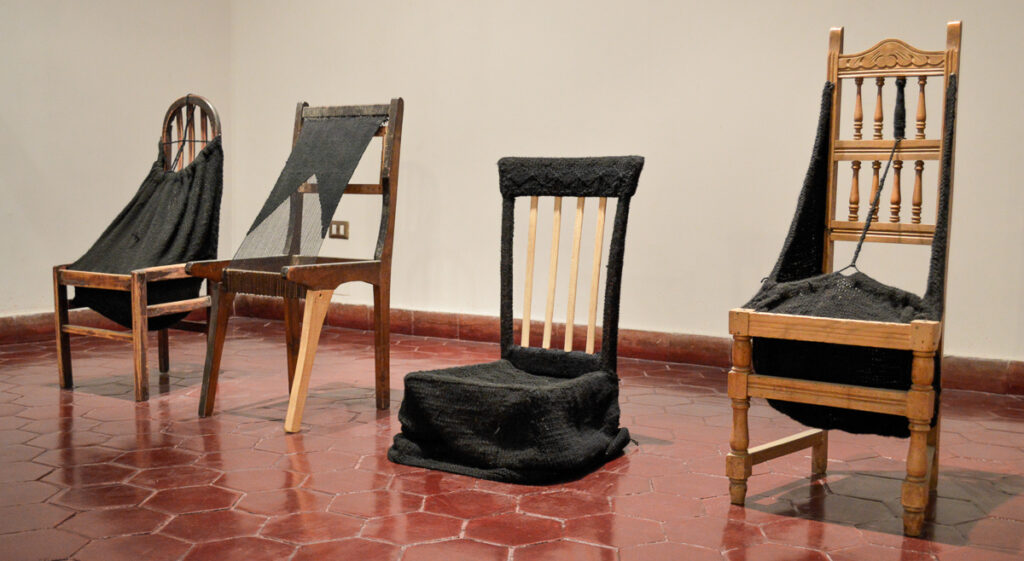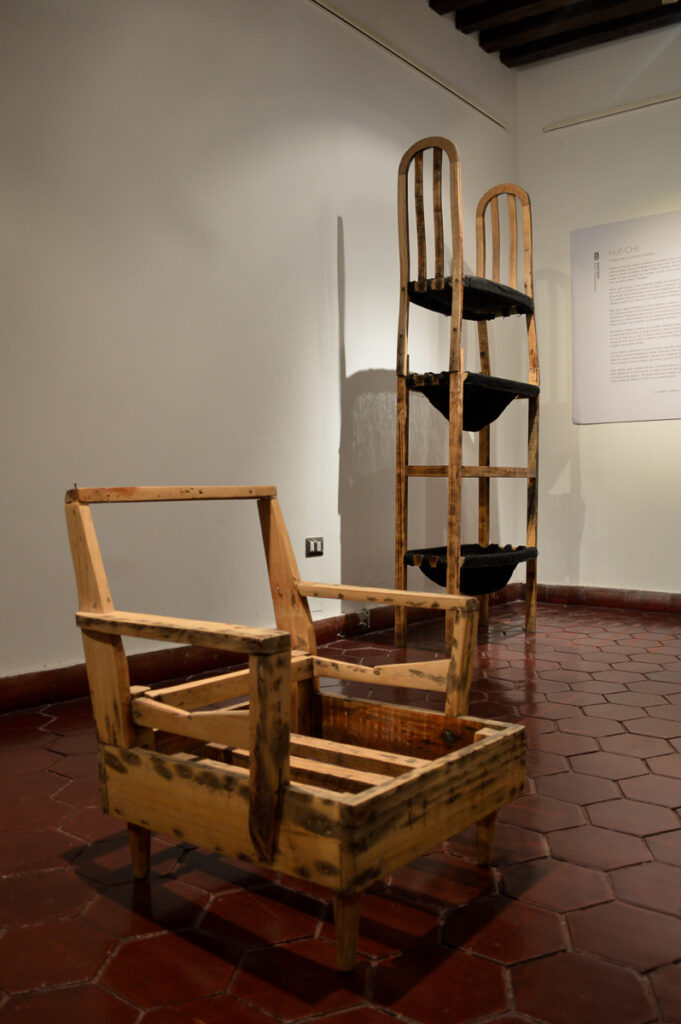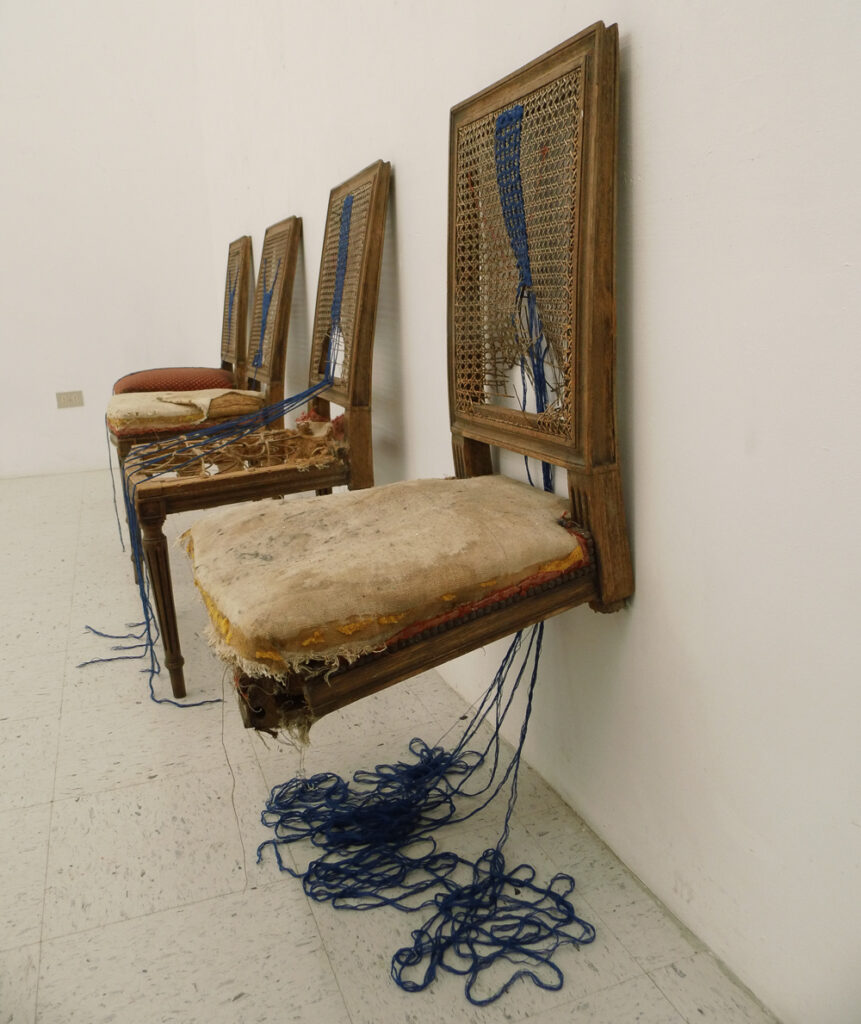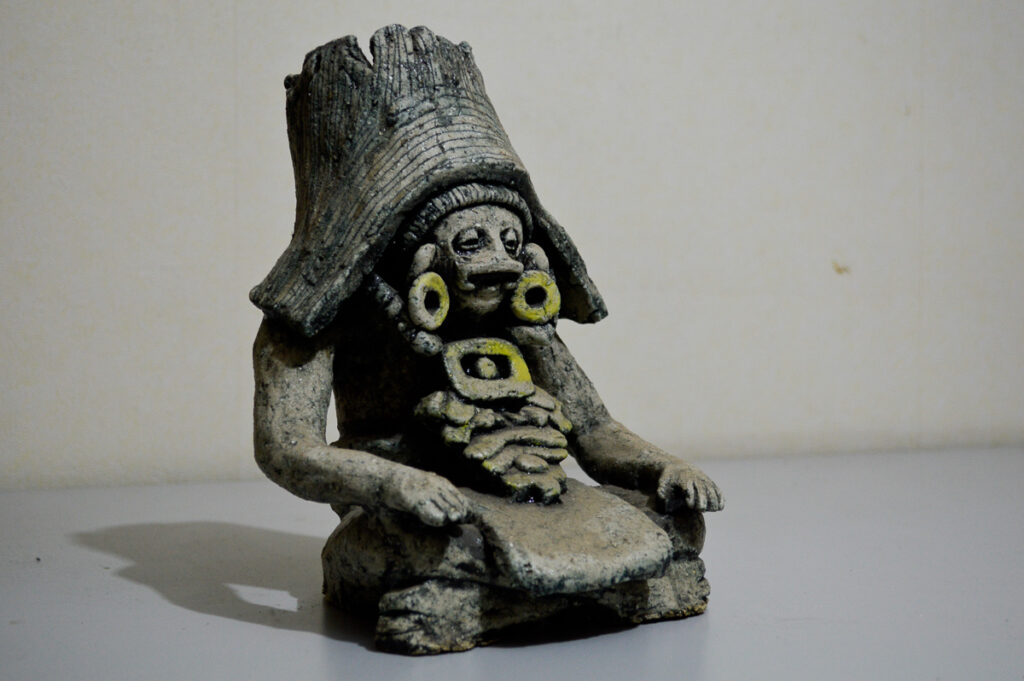Rodrigo Castro Hueche follows his family’s furniture work to craft objects that reflect a hybrid Mapuche identity.
(A message to the reader in Mapudungun, Spanish and English.)
I was born in the town of La Pincoya. My father is a carpenter and my mother a weaver. I am the fourth child of six sisters and brothers. I was born deaf-mute from my Mapuzugun (Mapuche language), but I always knew what we are. My grandfather’s surname “Hueche” means “young” in our language. With the little to share, he was able to give me a very initial kimün (wisdom), almost imperceptible, like a spark in a dark space that illuminates the whole when it ignites.
I am a Mapuche born in the city. Like all of us who arrived here, I was cast to fortune and inhabit the periphery, that permeable, porous and grey border where the rural and the urban intermingle. The periphery shapes our changing identities, mutable and dissident, dislocated from the ancestral territory.
In this way, I shape my imaginary, as a map-city, a Mapuche from the city, or rather, from the suburbs, where crime and drug addiction are daily bread, as well as community life, neighbours, the kiosk, the neighbourhood stores and the municipal schools that, rather than providing education, delivered breakfast and lunch. My memories are of the blocks, these state housing solutions, of walking in the street, with the sun hitting our faces to illuminate our beautiful brownness.
This imaginary, of marginal, emergent and urgent solutions,”workers” and proletarian solutions, has impregnated my artistic work, what I saw, what I lived, what I experienced when I was little. I accompanied my father to work, knowing of wood, furniture and upholstery, of being at home bored with my sisters. My mother gave us some long nails to weave with a stick and now as an adult, she reveals to me that I was the one who wove the thickest, with the best continuous and even point.
This mixture, this hybridisation of my father and my mother, of the fabric and the furniture, of the rural and the urban, the Mapuche and the non-Mapuche (or Chilean), which beyond being structural binarisms I see as a field of exploration border, where the feminine and the masculine also came into play and also many other areas that exceed the colonial structures. In short, everything that makes up my identity, be it class, race, gender, spirituality, tradition, culture and sexuality is in a constant play.
This is how my furniture arises, as complex subjects made up of all these edges of a particular reality, but which has the power to speak a common language with people who inhabit a similar condition. The furniture that I use in my work I pick up from the streets, from vacant places like garbage dumps, peripheral places, no man’s land and in turn everyone’s. These pieces of furniture inhabit these randomly thrown spaces, like our families who came to the margins of the city to occupy that beautiful landscape stained with brown and Indian.
I was always Indigenous. I always looked in a Mapuche way. When I make art or works of art I understand these objects as a replica of myself, of creating through furniture other complex subjects that touch and are affected by my identity and thus build new ones. identities, new possible “mupuchicity”.
The “Pü Fütametawe” series or the series of the containers are replicas of my identity, half of my father and mother, the black fabric sheltering the wood, making bundles or sacks as possible pregnant people or ready to begin existence, sheltering a hybrid son, abrogating me, welcoming me and understanding me in my hybridity, in my fluid identity and thus understand my feminine and masculine energies.
I understand these chairs as containers, as large vessels that hold secret threads of my memory, which is a story shared with all my sisters and brothers who identify with my artistic work and thus create community.
After this introspective investigation of myself as a container that holds ancient and ancestral knowledge, as well as current experiences of living in this contemporaneity, I began to work with clay, with ceramics related to Indigenous or native peoples. The vessels, urns, containers, flasks keep the secrets of a people. The important thing about this pottery is the interior moulding of the piece contains, stores and preserves liquids and food. I see in these vessels guardians of our ancestral heritage.
That is why I borrowed Mexican aesthetics to make a skull where I draw tribal motifs and symbols of Mapuche textiles, the skull as a container of knowledge. Likewise, I make a Zapotec piracy replica of an anthropomorphic figure, stressing this pre-Columbian knowledge with today’s industrial materials, updating the look and bringing to the present imaginaries that are apparently forgotten in an almost extinct, archaeological past. Also, the ceramic chemamulls (wooden statues) are created with this idea of preserving, protecting and storing, since the chemamulls are funeral statuettes that keep the spirit of the deceased person so that they have a good rest and do not remain to roam this world.
Finally, both furniture and ceramics challenge us in our history, in our identities, whether in our identity even in crisis as Latin Americans or in my Mapuche identity. All people have something contained, an energy, a knowledge and an experience of life, we save our vital energy, we protect it, we conserve it and we mature. It is like chicha, muday or wine, which we must spend decades aging to obtain fermentation and nurture a good flavour. The flavour of the world is enriched by our diversity.
Through a decolonial gaze, I deconstruct furniture as a metaphor for the deconstruction of identity. My domestic furniture are subjects that have suffered the effects of the various processes of civilisation and modernisation. They are hybrid bodies whose biographical, ethnic and cultural elements are intertwined to problematise the indigenous body that inhabits the current urban space. They are subjects who have suffered the Mapuche diaspora and its identity crisis.
The Mapuche cannot be conceived without his land. He is born, lives and dies for it. But the saddest is the one who does not possess it. He has no place other than the periphery and marginality to live. His death occurs in the absence of that source, which is the land and identity. That lack is the reality of the mestizo as a hybrid that lives the continuous displacement of place. This is how the mestizo body is born as the promise of a mixture that does not take place.
Author
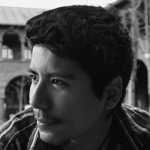 Rodrigo Castro Hueche has a degree in Visual Arts and a Master of Art at the Universidad Católica de Chile. He has exhibited individually at Espacio “O” contemporary art centre in Santiago de Chile (2017). Collectively he has exhibited at Campus Oriente on the occasion of his participation in the IV La Tirana Mobile Residence as a selected resident in 2016. In 2018 he has exhibited at the Casa Colorada Gallery and at the Estación Mapocho Cultural Center with his exhibitions “HUE-CHE” and “Ni Castro , Ni Hueche ”.
Rodrigo Castro Hueche has a degree in Visual Arts and a Master of Art at the Universidad Católica de Chile. He has exhibited individually at Espacio “O” contemporary art centre in Santiago de Chile (2017). Collectively he has exhibited at Campus Oriente on the occasion of his participation in the IV La Tirana Mobile Residence as a selected resident in 2016. In 2018 he has exhibited at the Casa Colorada Gallery and at the Estación Mapocho Cultural Center with his exhibitions “HUE-CHE” and “Ni Castro , Ni Hueche ”.
Spanish original
Nací en la población La Pincoya, mi padre es carpintero y mi madre tejedora, soy el cuarto hijo de 6 hermanas y hermanos. Nací sordo mudo de mi mapuzugun (idioma mapuche), pero siempre supe que los somos, mi abuelo de apellido Hueche que en nuestro idioma significa “joven” con lo poco y nada que compartimos fue capaz de entregarme un kimün (sabiduría) muy inicial, casi imperceptible, como una chispa en un espacio oscuro que cuando arde ilumina todo el lugar.
Soy mapuche nacido en la ciudad, como todas y todos los que llegamos aquí, tirados a la suerte y al azar habitamos la periferia, esa frontera permeable, porosa y gris donde lo rural y lo urbano se entremezcla para conformar nuestras identidades dislocadas, cambiantes, mutables y disidentes del territorio ancestral.
De esta manera conformo mi imaginario, como map-urbe, un mapuche de la ciudad, mejor dicho, de los suburbios, donde la delincuencia y la drogadicción eran pan de cada día, así mismo la vida en comunidad, los vecinos, el quiosco, los almacenes de barrio y los colegios municipales que, más que entregar educación, entregaban desayudo y comida. Mis recuerdos son de los blocks, estas soluciones habitacionales estatales, de andar en la calle, con el sol pegando al rostro haciendo brotar agua para iluminar nuestra hermosa morenidad.
Este imaginario, de las soluciones marginales, emergentes y urgentes, soluciones obreras y proletariadas lo llevo impregnado en mi hacer artístico, de lo que vi, de lo que viví, lo que experimenté cuando pequeño, de acompañar a mi padre al trabajo, el saber de la madera, los muebles y la carpintería de retapicero, de estar en casa aburrido con mis hermanas y que mi madre nos pasara unos clavos largos para tejer a palillo y ahora cuando adulto me revela que yo era el que tejía más tupido, con el punto mejor continuado y parejo.
Esta mezcla, esta hibridación de mi padre y mi madre, del tejido y el mueble, de lo rural y lo urbano, lo mapuche y lo no mapuche (o chileno), que más allá de ser binarismos estructurales los veo como un campo de exploración fronteriza, donde lo femenino y lo masculino también entraba en juego y también muchas otras áreas que exceden las estructuras coloniales. En fin, todo lo que compone mi identidad, ya sea clase, raza, género, espiritualidad, tradición, cultura y sexualidad está en un constante juego de interrelaciones.
Así surgen mis muebles, como sujetos complejos compuestos por todas estas aristas de una realidad particular, pero que tiene el poder de hablar un lenguaje común con las personas que habitan una condición similar. Los muebles que ocupo en mi obra los recojo de las calles, de sitios eriazos que se agencian casi como basureros, lugares periféricos, la tierra de nadie y a su vez la de todos. Estos muebles habitan estos espacios botados al azar, así como también nosotros cuando nuestras familias llegaron a los márgenes de la ciudad para componer ese hermoso paisaje manchado de marrón y de indiada.
Siempre fui indígena, siempre miré de una manera mapuche y cuando hago arte o obras de arte lo entiendo estos objetos como una réplica de mi mismo, de crear a través del mueble otros sujetos complejos que toquen y sean afectados por mi identidad y así construir nuevas identidades, nuevas mapuchidades posibles.
La serie “Pü Fütametawe” o la serie de los contenedores tiene que ver con esto que relato, son réplicas de mi identidad, la mitad de mi padre y mi madre, el tejido negro abrigando la madera, haciendo bultos o sacos como posibles personas embarazadas o prontas a dar comienzo la existencia, abrigando un hijo híbrido, abrogándome, acogiéndome y entendiéndome en mi hibridez, en mi identidad fluida y así entender mis energías femeninas y masculinas.
Comprendo estas sillas como contenedores, como grandes vasijas que guardan hilos secretos de mi memoria, que es una historia compartida con todas mis hermanas y hermanos que se sientan identificados con mi hacer artístico y así hacer comunidad.
Después de esta investigación reflexiva, introspectiva de entenderme como un contenedor que guarda los saberes milenarios y ancestrales, como también las experiencias actuales de vivir en esta contemporaneidad comencé a trabajar con barro, con cerámica con pertinencia indígena o de pueblo originario. Las vasijas, urnas, contenedores, matraces que guardan los secretos de un pueblo y que lo importante de esta alfarería es el moldeado interior de la pieza, su interior, lizo, impoluto para contener, guardar y conservar líquidos y alimentos, ver en estas vasijas guardianes de nuestro patrimonio ancestral.
Es por ello que tomo prestada la estética mexicana para hacer un cráneo donde dibujo motivos tribales y símbolos de la textilería mapuche, el cráneo como contenedor del saber. Así mismo, hago una réplica de piratería zapoteca de una figura antropomorfa, tensionando este saber precolombino con los materiales industriales de hoy, actualizando la mirada y trayendo al presente imaginarios que aparentemente están olvidados en un pasado casi extinto, arqueológico. También los chemamull cerámicos son creados bajo esta idea de conservar, proteger y guardar, ya que los chemamull son estatuillas funerarias que guardan el espíritu de la persona fallecida para que tenga un buen descanso y no quede rodando en este mundo.
Finalmente, tanto los muebles como las cerámicas nos interpelan en nuestra historia, en nuestras identidades, ya sea en nuestra identidad aun en crisis como latinoamericanos o en mi identidad mapuche. Todas las personas tenemos algo contenido, una energía, un saber y una experiencia de vida, guardamos nuestra energía vital, la protegemos, la conservamos y maduramos. Así como la chicha, el muday o el vino, que tienen que pasar años, décadas añejándose para conservar así su fermentación y obtener un buen sabor. Así mismo las personas pasamos experimentando nuestros secretos y así obtener un (o varios) sabor(es), el sabor del mundo radica en nuestras diversidades.
Bajo una mirada decolonial deconstruyo e intervengo muebles, como un símil a la deconstrucción de la identidad, viendo al mobiliario doméstico como sujetos que han sufrido los efectos de los diversos procesos de civilización y modernización. Cuerpos puramente híbridos donde pasajes biográficos, étnicos y culturales se mezclan y entrecruzan para problematizar el cuerpo indígena que habita el espacio urbano actual. Sujetos que han sufrido la diáspora mapuche y su crisis de identidad.
El mapuche no se concibe sin su tierra, nace, vive y muere por ella, pero más triste es el que no la posee, no tiene lugar más que la periferia y la marginalidad para vivir. Su muerte ocurre en la ausencia de esa fuente, que son la tierra y la identidad. Esa falta es la realidad del mestizo; un híbrido que vive en la completa falta y en continuo desplazamiento de lugar. Así nace el cuerpo mestizo, como una mezcla, una hibridación que no tiene lugar.


